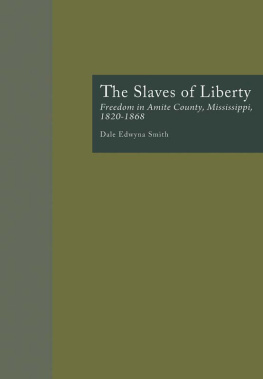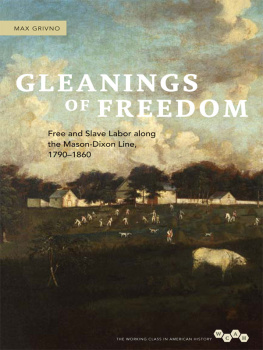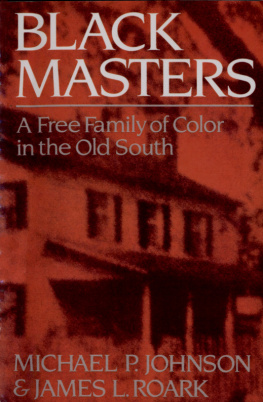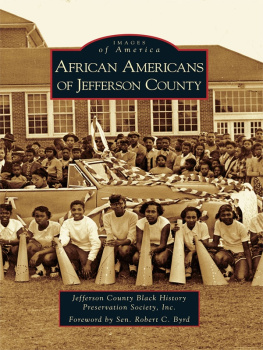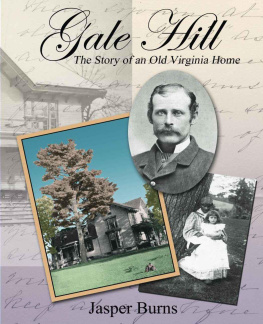FREEDOM HAS A FACECarter G. Woodson Institute Series
Deborah E. McDowell, Editor
University of Virginia Press
2012 by the Rector and Visitors of the University of Virginia
All rights reserved
Printed in the United States of America on acid-free paper
First published 2012
1 3 5 7 9 8 6 4 2
LIBRARY OF CONGRESS CATALOGING-IN-PUBLICATION DATA
Von Daacke, Kirt, 1968
Freedom has a face : race, identity, and community in Jeffersons Virginia / Kirt von Daacke.
p. cm. (Carter G. Woodson Institute series)
Includes bibliographical references and index.
ISBN 978-0-8139-3309-2 (cloth : alk. paper) ISBN 978-0-8139-3310-8 (e-book)
1. Free African AmericansVirginiaAlbemarle CountyHistory19th century. 2. Free African AmericansVirginiaAlbemarle CountySocial conditions19th century. 3. Albemarle County (Va.)Race relations. 4. Albemarle County (Va.)History19th century. I. Title.
F232.A3V66 2012
305.896'0755482dc23
2012008718
Acknowledgments
Over the many years of working on this project, I have compiled a long list of people and organizations to whom I owe thanks. I could not have produced this book without all of their helpI am grateful beyond words for all of the assistance, love, and support they provided and doubt that their acknowledgment here truly repays them for their help.
I was blessed with two professors who were academic mentors of the highest order: Reginald D. Butler and Michael P. Johnson. I hope my book in some small way lives up to their great expectations. The kernel of inspiration for this project grew out of some classes I took as an undergraduate at the University of Virginia with Reginald D. Butler. His patient guidance, high standards, and trenchant criticisms changed the direction of my scholarly interests and prepared me for graduate school. I cannot thank him enough both for that start years ago and for his continuing advice long after I had left UVA.
Michael P. Johnson changed my life the day he called and invited me personally to come to The Johns Hopkins University to work with him as a graduate student. Ever since, I have been lucky to count him as a mentor and friend. While I was in graduate school, every meeting I had with him tore down and quietly helped reshape my scholarship but somehow sent me out the door feeling better and more confident. He has remained to this day a ceaseless supporter of my research and my professional ambitions and a model for how to treat students. In addition to a debt of gratitude for all that, I probably also owe him several meals out, preferably for ribs and beer.
At Hopkins, Ronald Walterss guidance and assistanceboth in Baltimore and sincemake me glad to be a historian. Philip Morgan, Toby Ditz, Jane Dailey, and Jack Greene all deserve a huge thank you for their criticism and scholarly advice about my research. Outside of Baltimore, a number of other scholars offered excellent commentary and questions about parts of this project: Melvyn P. Ely, Peter Wallenstein, Tony Iaccarino, Laura Edwards, and Sabita Manian. Special thanks to Maurie McInnis for directing me to the image that appears on the coverI never would have found it without her expert assistance.
I also had the good fortune of meeting Robert Vernon, a lay historian in Charlottesville, Virginia, who was then in the process of compiling a guide to county records concerning free blacks. This partial guide represented an amazing introduction to the documentary record. He generously gave me a copy of the draft-in-progress. Thanks to Vernon, I had a list of free black names as well as a set of basic directions for navigating often confusing collectionsVernons guide provided the key for deciphering the story of free black life in Albemarle.
My time at UVA, around the Hopkins seminar table, and at academic conferences has been invaluable. I am lucky to know Jeff McClurken, George Baca, Andy Lewis, Dylan Penningroth, Natalie Ring, Josh Rothman, and Mark Thompson as good friends whose intellectual insights and humor continue to nourish me. I eagerly await my next fine dinner out at a conference with Jeff, Josh, and Natalie, as long as we never eat again at any place named Pancho Villas. I am sure I owe each of them a drink.
My former colleagues in the Lynchburg College History DepartmentNichole Sanders, Brian Crim, James Owens, and Scott Amosprovided critical commentary as well as companionship and support. I could not ask for better colleagues and friends. We also shared a few amazing students, whose own work on the antebellum South inspired me to persevere through the long publication process. Thanks to Charlotte Arbogast, John Marks, and Ashley Schmidt for their excellent research and writing. Jon Shipe spent the better part of a summer as a graduate assistant making manuscript-formatting corrections and chasing down whatever errand I sent him on.
I benefited greatly from my time as a Batten Fellow at the International Center for Jefferson Studies and from a year as a visiting scholar at the Carter G. Woodson Institute for Afro-American and African Affairs at the University of Virginia. There, Peter Onuf and Cinder Stanton did wonders for my understanding of Jeffersons writings on race and of the Hemings family. Lynchburg College also gave important support by providing both a summer faculty research grant and a travel grant for the project. The Virginia Foundation for Independent Colleges Mednick Memorial Fellowship provided important financial support as well, allowing me to spend three comfortable weeks doing research at the Library of Virginia.
The knowledgeable archivists and librarians at the Library of Virginia, the Virginia Historical Society, the Virginia Baptist Historical Society, and the University of Virginias Albert and Shirley Small Special Collections Library proved invaluable during my years of digging through all those musty county records. Any historian doing local historical research likely owes a huge thank you to at least one local lay historian, genealogist, or compiler. Bob Vernon graciously shared with me his draft-in-progress guide to African American records in Albemarleit was my personal Rosetta stone that unlocked the mysteries of those county records.
At the University of Virginia Press, Dick Holway, Raennah Mitchell, and Morgan Myers patiently guided the book through acquisition and editing. All three happily answered my questions, solved my computing dilemmas, and caught mistakes. Melvyn P. Elys guidance, first as a reviewer and then as a sensitive reader providing page-by-page editorial commentary, improved this book immeasurably. I cannot thank him enough for all the time he took to help me shape the bookthe final product would not be what it is without his interventions. While I owe him for that effort, I remain solely responsible for any errors that appear within.
Since I began the long process of creating this book, my wife, Nicole Eramo, has been there at every moment, offering criticism of my writing, lending a copy-editing hand, providing critical analysis, listening to me fulminate at one thing or another, and always supporting me through the process. She did this while herself pursuing a doctorate, working full-time as a dean, and being a wonderful mother to our lovely son. Shes the most beautiful, talented, and amazing person I have ever met, and this book could not have happened without her.
My parents, Fred and Nancy von Daacke, have always provided financial and emotional assistance and, far more important, moral and intellectual support. They have long been my role models in life and learning. I would not know where to begin in thanking them for all they have done. It was my fathers own passion as a father, a mentor, a historian, and a teacher that pushed me toward this avocation. I dedicate this book to him.


